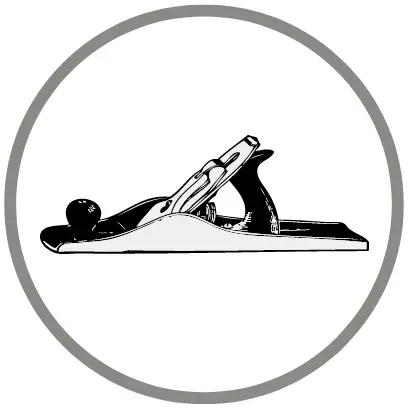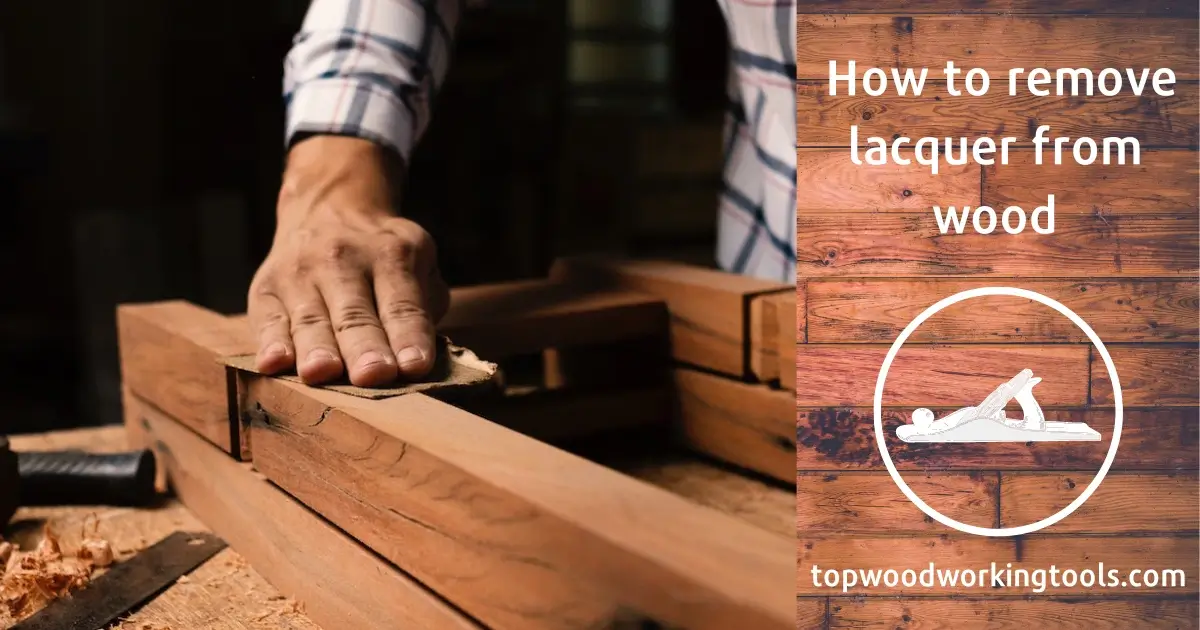Knowing how to remove lacquer from wood will come in handy for plenty of projects. It is an essential skill if you want to flip wooden furniture. But it is also necessary for a single project if you would like to renovate a precious piece of your family’s history.
In the following piece, I will concentrate exactly on the proper techniques for removing lacquer from wood. And you will be able to use those recommendations for a wide variety of jobs, ranging from refinishing wooden flooring to preparing salvaged pieces of wood for further use.
Contents
- 1 Differences between lacquer and varnish
- 2 Types of lacquer
- 3 Properties of a layer of dried lacquer
- 4 How to remove lacquer from wood with paint strippers
- 5 How to remove lacquer from wood with other chemicals
- 6 How to remove lacquer from wood by sanding
- 7 How to remove lacquer from wood with heat
- 8 Choosing the best method
- 9 Q&A bit
- 10 Wrapping it up
Differences between lacquer and varnish
Lacquer and varnish are commonly used as synonyms. But there are some significant differences between those types of products. Such differences affect both application and final removal. And in this article, I’ll concentrate specifically on dealing with an old coat of lacquer on wood furniture.
Lacquer and varnish are both clear coatings used to protect and enhance materials, but lacquer is typically harder, dries faster, and produces a glossier finish, while varnish is softer, dries slower, and produces a more matte lacquer finish.
Fortunately, every paint stripper and lacquer stripper can serve as a varnish remover too.
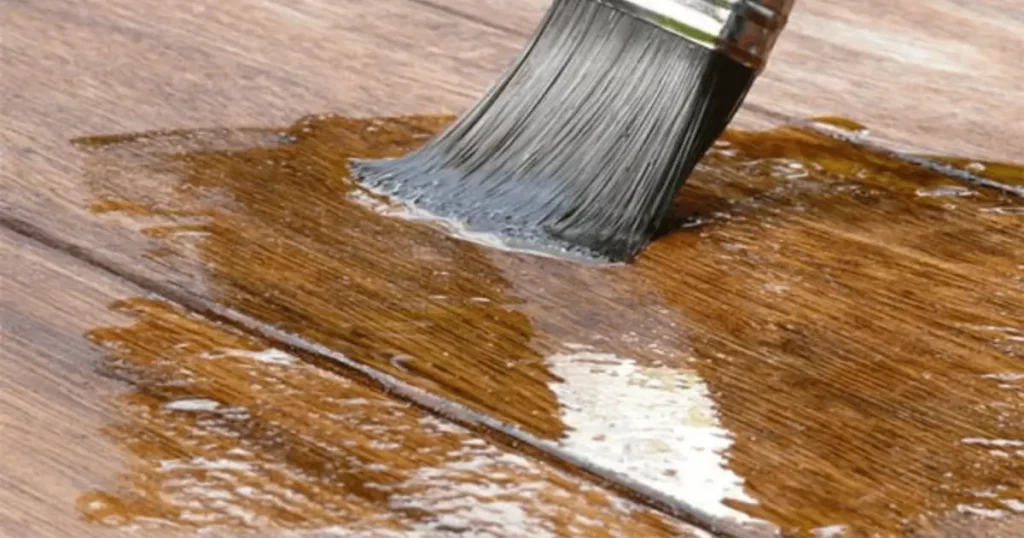
Types of lacquer
Lacquer is a type of clear coating that is applied to flat surfaces to provide a durable and glossy lacquer finish. Some lacquers remain clear, while others are prone to slight changes of color over time. Also, some of them are tinted intentionally.
Lacquer is typically made from a mixture that includes:
- natural or synthetic resins;
- solvents (mineral spirits for instance) that serve as a lacquer thinner;
- other additives that alternate viscosity, drying time, and other parameters.
Lacquer can be applied to a variety of materials including wood, metal, and plastic.
Lacquer is known for its fast-drying properties and its ability to create a smooth and highly reflective surface. It has been used for centuries in traditional Asian art and design and is also commonly used in modern industrial, and commercial applications, and hobby projects.
Natural lacquers
Natural lacquers are coatings made from the sap of certain trees, particularly the lacquer tree, some species of bugs, along with other sources.
The sap of the lacquer tree is collected and then processed to create a durable, glossy lacquer finish that is highly valued for its beauty and resistance to water and other types of damage.
Natural lacquers have been used for thousands of years across the world for a variety of decorative and practical purposes, including making lacquerware, finishing wooden furniture, and musical instruments.
Today, natural lacquers are still used in traditional crafts, although synthetic lacquers have largely replaced them in industrial and commercial applications due to their lower cost and easier availability.
Synthetic lacquers
Synthetic lacquers are coatings that are made from synthetic materials rather than natural resins. They are typically made out of a mixture that includes:
- polymers (nitrocellulose, acryls, polyurethanes);
- solvents similar to mineral spirits;
- other additives that are designed to produce a durable, glossy lacquer finish that is resistant to wear, chemicals, and weathering.
Synthetic lacquers have several advantages over natural lacquers, including lower cost, greater consistency, and a wider range of available colors and finishes.
Such advantages made synthetic lacquers common for a variety of industrial and commercial applications, such as automotive and wooden furniture finishing.
The durability of a dried thin layer along with its availability made synthetic lacquers a common option for DIY projects and crafts.
Properties of a layer of dried lacquer
Dried lacquer, whether natural or synthetic, has several distinctive properties that make it a desirable coating for a wide range of flat surfaces. Some of the key properties of dried lacquer include:
- Wood surface protection: Dried lacquer forms a hard, protective layer on the surface of the material it is applied to, providing some resistance to scratches, impacts, and other types of damage.
- Gloss: Lacquer has a natural shine that gives surfaces a glossy, reflective lacquer finish when dried. There are lacquers that produce different sheens depending on additives.
- Water resistance: Most lacquers are highly resistant to water and other liquids, making them an ideal coating for items that may be exposed to moisture or wet environments.
- Chemical resistance: Lacquer is also resistant to many types of chemicals, including some solvents and acids, making it a popular coating for industrial and commercial applications. On the other hand, there are solvents formulated specifically to loosen lacquer coatings.
- Adhesion: Lacquer has excellent adhesion properties, allowing it to bond strongly to wood and a variety of other surfaces.
- Quick drying time: Lacquer dries quickly, which allows for multiple coats to be applied in a relatively short amount of time. Especially if it has respective additives that promote drying time.
These properties make dried lacquer a versatile and durable coating that is suitable for a wide range of uses, from fine art to wooden furniture to automotive finishes.
Also, these properties create all the trouble when you are trying to refinish a piece of wooden furniture. Fortunately, there are several common techniques that you can use to take the old lacquer off a wooden surface.
How to remove lacquer from wood with paint strippers
Chemical paint-stripping compounds are the most common solution for removing lacquer from wood. Their main intention is to remove acrylic paints and other types of paints, but they will work on lacquer too. Though, such products are usually really toxic and require care to be used properly.
Required tools
To be able to remove lacquer from wood with a paint stripper, you’ll be going to need the following:
- a paint stripper product itself (there are products specifically formulated to work with lacquers, but any usual paint stripper will do);
- a plastic food wrap or aluminum foil to wrap the piece covered in the paint stripper;
- a paintbrush for application;
- a scraper to remove loosened lacquer (use metal ones, as a scraper made of plastic can get dissolved);
- medium fine steel wool or fine sandpaper to remove the remaining lacquer;
- a rag to clean up the wood surface;
- a bucket to safely collect and dispose of the loosened lacquer remains mixed with the product (see manufacturer’s instructions for disposal on the packaging of the paint-stripper);
- a drop cloth to protect the surfaces of your working space.
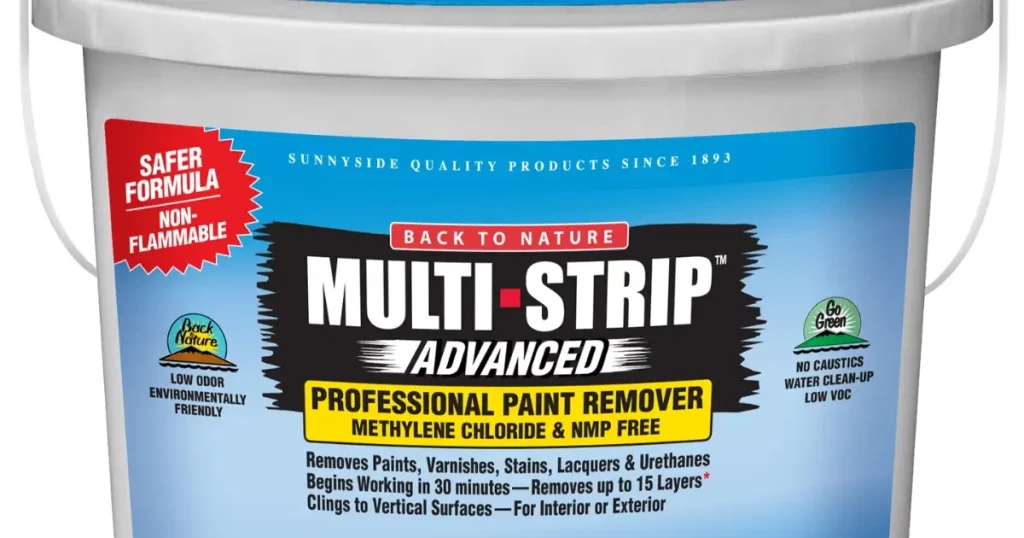
Preparation
Begin preparation by removing everything that is not supposed to be covered in the product from the piece. Decorative and functional elements made of metal, for instance. Then make sure nothing will get in the way between the product and the lacquer (stickers, adhesive residue, etc.)
Then prepare the working area by placing the drop cloth over the estimated working area. The rest of the preparations are needed to make sure there will be no harm to your health.
Safety measures for working with paint strippers
Paint and lacquer stripping solutions are typically pretty toxic, so you will have to follow safety measures carefully.
- firstly, follow the manufacturer’s instructions for the paint stripper, lacquer, or varnish remover;
- make sure that the working area is well-ventilated;
- use protective gear: rubber gloves, goggles, breath protection, and clothing;
- avoid using heat or open flame, as some products contain highly flammable components.
Actual process
After preparing all the needed tools and following all precautionary measures, it’s time to actually remove the lacquer from the wood. The following steps will walk you through the process:
- Apply the paint stripper to the surface of the lacquered material, using a paintbrush.
- Wrap the surface in a food wrap or aluminum foil to prevent fast evaporation.
- Allow the stripper to sit for the recommended amount of time, typically 15–30 minutes.
- Use a scraper to gently remove the loosened lacquer and put it into the prepared bucket or bag. Follow the direction of the wood grain while working.
- Use steel wool to remove any remaining traces of lacquer. Dip steel wool into respective solvents, denatured alcohol, or a lacquer thinner to promote cleaning.
- Sand the surface to remove any remaining residue and to smoothen out the wood grain.
- Clean the surface with a rag and allow it to dry completely.
Pro-tip: Use a toothpick, a profiled scraper, and a folded piece of fine sandpaper to reach the deeper nooks and crannies for complete removal of the residue.
If the first application failed to remove the lacquer completely, apply some lacquer remover once again. Liquid lacquer tends to pool inside the depressions in the relief of the surface, forming a thick coat in some areas.
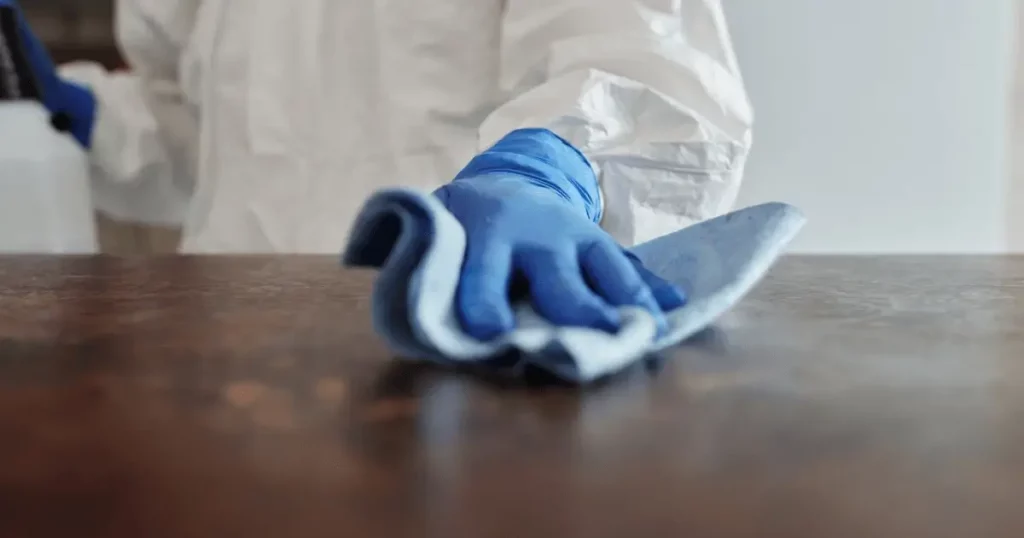
How to remove lacquer from wood with other chemicals
There are several chemicals that can be used to remove lacquer from wood, aside from paint strippers or a varnish remover. Here are a few examples of chemicals that can serve as a liquid remover for lacquer:
- Denatured alcohol: This is a solvent that can be effective at removing lacquer from wood. Apply it to the surface using a rag, and then use a scraper or steel wool to remove the loosened lacquer.
- Acetone: Acetone is a powerful solvent that can dissolve lacquer. It’s important to work in a well-ventilated area and avoid using heat or open flames. Apply it to the surface using a rag or brush, and then use a scraper or medium-fine steel wool to remove the loosened lacquer.
- Toluene: Toluene is another part of a paint thinner or a separate solvent that can dissolve lacquer. Like acetone, it’s significant to work in a well-ventilated area and avoid using heat or open flame. Apply it to the surface using a rag or brush, and then use a scraper or steel wool to remove the loosened lacquer.
- Vinegar: White vinegar can be used to remove lacquer from wood, though it may require several applications.
It’s essential to note that chemicals similar to denatured alcohol and lacquer thinner, as well as other solvents, can be hazardous, and it’s important to follow all safety precautions. Especially in regard to flammability and hazardous vapors.
Additionally, it’s always a good idea to test the chemical on a small, inconspicuous area before using it on the entire wood surface to ensure that it won’t damage the wood and will actually affect the layer.
How to remove lacquer from wood by sanding
Physically removing the old lacquer from a piece of wood is always an option too. It will be messy, and it will take much more time than going for chemical removal, but sometimes it is the best option. After all, sanding is a big part of woodworking.
Required tools
Sanding the lacquer away is a pretty straightforward stripping process, and it requires the following tools:
- sandpaper in various grits (60, 100, 150, 220);
- sanding block or power sander;
- dust mask or respirator;
- eye protection;
- gloves;
- breathing protection;
- a tack cloth or a vacuum cleaner.
If you’re going to use sanding machines, be careful not to sand too much. Also, keep an eye on lacquer dust bundling up. Clots of compressed dust can scratch the surface of the wood quite significantly.
Tip. Furthermore, you can read more about Best furniture sander reviews and buying guide.
Preparation
Sanding is a dusty and messy process, so make sure you are ready to deal with all the dust flying in the air.
- remove all the decorative and functional elements of your piece if it is possible;
- lay down a drop cloth or other protective covering;
- wear protective gear, including a dust mask or respirator, eye protection, and gloves.
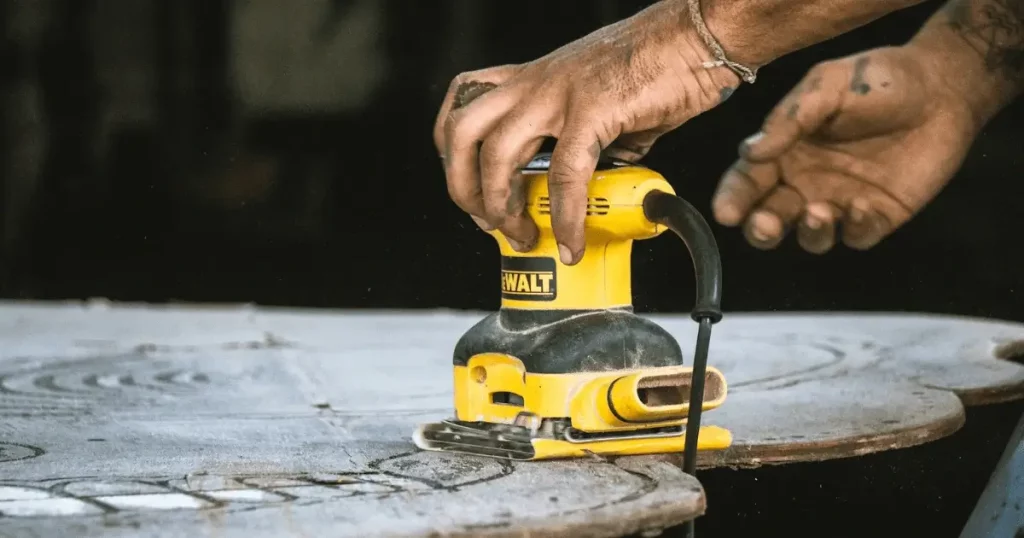
Safety measures
Most of the potential hazards of sanding down some old lacquers are due to the dust and the possibility of damaging the underlying wood.
- work in a well-ventilated area;
- sand in the direction of the wood grain to avoid damaging the surface;
- avoid using excessive force or pressure to prevent damaging the wood;
- be aware of the hazards of inhaling dust and wear proper protection.
Remember that fine wood dust suspended in the air can be extremely combustible. Pay special attention to fire-related safety measures.
Actual process
After sorting out all the safety and preparing the needed tools, it is time to start the work by following the steps presented below:
- Begin by sanding the surface of the lacquered material using coarse sandpaper, such as 60 or 100 grit. Use a sanding block or an orbital sander to make the process easier and more efficient.
- Gradually work through medium-grit sandpaper up to finer-grit sandpaper, such as 150 or 220 grit, until all the lacquer has been removed and the wood smooth.
- Follow the grain of the wood to prevent fuzz on its surface.
- Be sure to sand the surface evenly, avoiding any low spots or high spots.
- Optionally, use steel wool for gentle removal of lacquer residue.
- Wipe down the surface with a tack cloth or rag to remove any dust or debris.
- Clean the surface with a damp cloth and allow it to dry completely before applying any new finish or coating.
It’s important to take your time when sanding away lacquer and to avoid damaging the underlying wood. Additionally, it’s essential to wear protective gear and dispose of used materials properly.
Scraping as an alternative to sanding
Really old lacquers or multiple layers that were applied carelessly can start flaking. You can use a metal scraper to take them away completely. But take extra care, as vigorous scraping can seriously damage the underlying wood.
In some instances, you will also be able to use a wire brush or even some steel wool to get rid of a lacquer that has already started to flake. But only use a wire brush on the hardwood in a great shape, as it can damage the surface of softer kinds of wood,
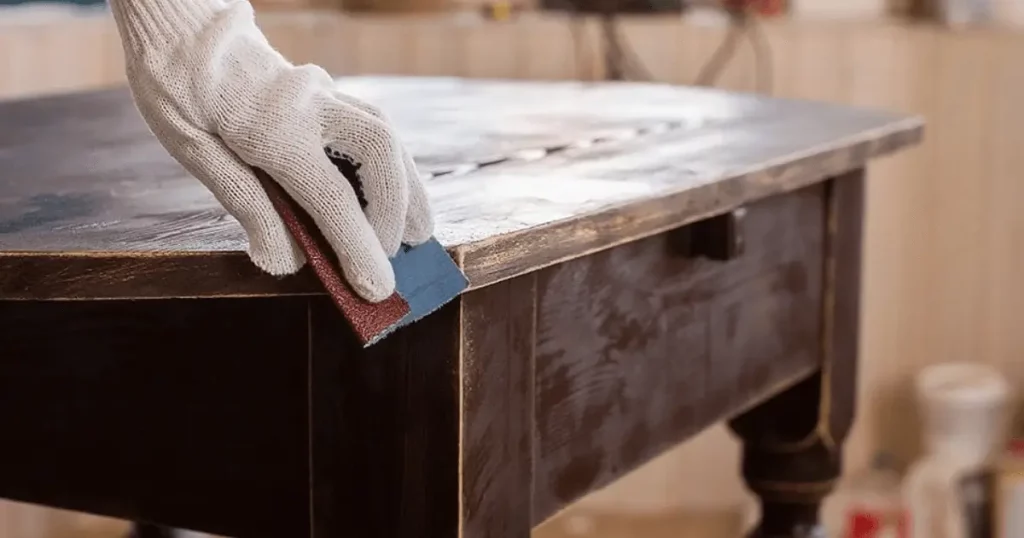
How to remove lacquer from wood with heat
Instead of trying to sand away or dissolve the old lacquer layer, you can try to loosen it by applying some heat. This method is the best for synthetic lacquers. A heat gun is your best shot in it. Try to refrain from using heaters with spirals or other tools.
Required tools
A heat gun and some protective gears are your main tools. The complete list of what you are going to need is below.
- heat gun or blow-dryer;
- paint scraper, putty knife, or coarse steel wool;
- gloves;
- eye protection;
- drop cloth or other protective covering;
Preparation
After gathering all the needed tools and safety gear, you will need to prepare the working area and the piece. When it comes to preparing the piece, you’ll just be going to need to take off all the decorative and functional elements.
To prepare the working area, make sure it is well-ventilated, and has no potentially flammable items around it, and lay down a drop cloth or other protective covering. You can use painter’s tape to prevent it from moving around.
Safety measures
Fire hazards and possible vapors of a synthetic lacquer are your main concerns. But the following list will help to have everything under control.
- be aware of the hazards of working with heat and wear proper protection;
- avoid using heat near flammable materials;
- work in a well-ventilated area;
- be cautious not to overheat the surface, which can damage the wood under the lacquer;
- wear protective gear, including rubber gloves and eye protection.
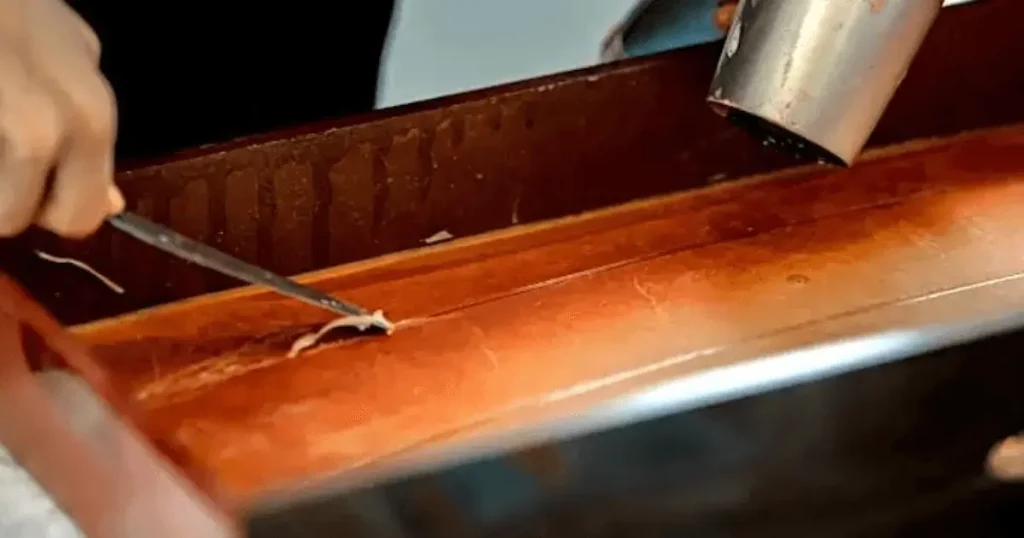
Actual process
The process of removing lacquer with heat is simple, but can potentially take some time.
- Use a heat gun or blow-dryer to warm the surface of the lacquered material. Hold the heat gun or dryer about 6 inches away from the surface and move it in a circular motion.
- Continue heating the surface until the lacquer softens and begins to bubble or blister.
- Use a paint scraper or putty knife to gently scrape or peel away the softened lacquer. Work slowly and carefully to avoid damaging the underlying wood.
- Repeat the stripping process, heating and scraping away the lacquer in small sections, until all the lacquer has been removed.
- Clean the surface with a damp cloth and allow it to dry completely before applying any new lacquer finish or coating.
Keep in mind that freshly removed lacquer as well as the surface that was under it remain pretty hot for a bit of time.
Choosing the best method
Choosing the best method to remove lacquer from wood depends on various factors, including the type of lacquer, the condition of the wood, the size, and shape of the object, and the resources available. Here are some considerations when choosing the best method to remove lacquer from wood:
- Type of lacquer: The type of lacquer, whether natural or synthetic, can affect the best removal method. For example, chemical strippers may be more effective for synthetic lacquers, while natural lacquers may require sanding or heat to remove.
- Condition of the wood: The condition of the wood can also affect the best removal method. If the wood is delicate or prone to damage, a gentle method like sanding or heat may be more appropriate. However, if the wood is in good condition and can withstand more aggressive methods, using a chemical stripper or a varnish remover may be a quicker and more effective option.
- Size and shape of the object: The size and shape of the object can also impact the best method for removal. For small, intricate objects, sanding, or heat may be the most practical method, while larger objects may require a stripping gel or an orbital sander.
- Resources available: The resources available, including tools and materials, can also impact the best removal method. For example, if you don’t have access to a chemical stripper, varnish remover, or an electric sander, sanding with steel wool or heat may be the only viable option.
Ultimately, the best method for removing lacquer from wood will depend on a variety of factors and will require careful consideration and evaluation. It may also be helpful to consult a professional or seek resources and guides specific to your particular situation.
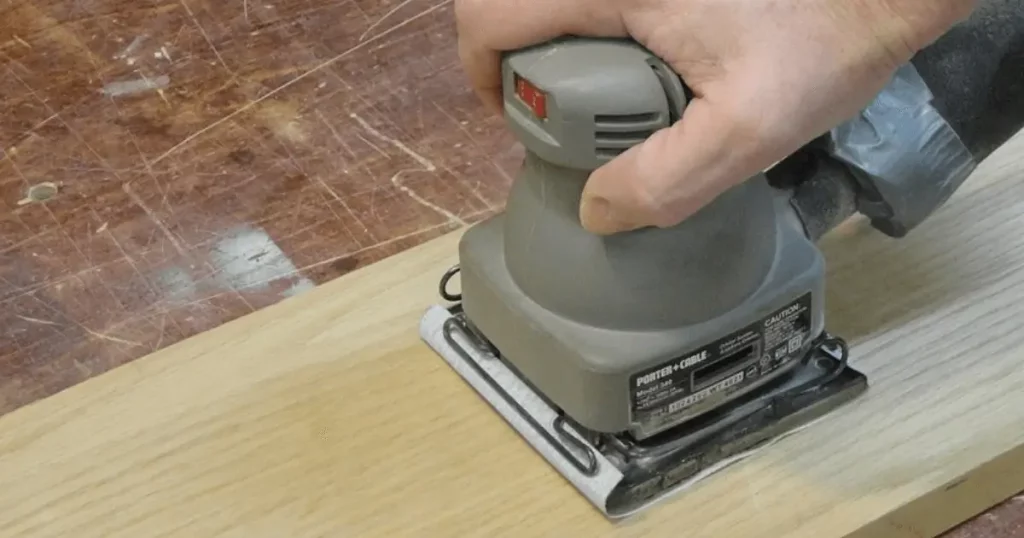
Q&A bit
Now, after figuring out all the basics regarding removing lacquer from wood, let’s answer some of the most popular questions.
What will dissolve lacquer?
There are numerous chemicals capable of removing lacquer from wood. Light sanding and acetone are the best shot to deal with lacquers based on natural resins.
Toluene or mineral spirits are good for synthetic lacquer. Just pick the chemical that is the best for the type of lacquer that was used to coat your piece.
If you don’t know what kind of product was used, try every available option on a small portion of it to figure out what will work best to remove the lacquer completely.
How do you remove spray lacquer from wood?
There is no need for any special techniques to remove spray lacquer finishes. Every spray lacquer dries to become the same dried layer. Just use one of the methods above, and you’ll be able to remove lacquer from the wood.
Tip. Can be also useful to check out the guide How to Remove Alcohol Stains From Wood.
Wrapping it up
Now you know how to remove lacquer from wood. All it takes from this point is just picking the most suitable method for your project and bringing it to life. Just take extra care and try not to damage the piece.

My name is Alex Mashinsky
I am an enthusiastic woodworking hobbyist who created topwoodworkingtools.com to provide helpful information and advice to fellow woodworkers.
The goal of the website is to help readers make informed decisions about woodworking tools and materials, with the ultimate aim of ensuring that they achieve the best possible results from their projects.
My main focus is on offering accurate, honest, and well-reasoned opinions and advice to help readers choose the most suitable tools and materials for their particular needs.
